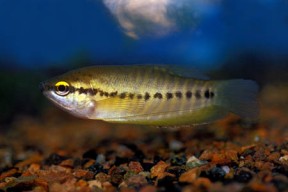Trichopodus pectoralis
Snakeskin Gourami
Classification
Osphronemidae. Subfamily: Luciocephalinae
Distribution
Occurs naturally in both the Mekong and Chao Phraya drainages in Vietnam, Laos, Cambodia, Thailand and Myanmar. It’s a popular food fish and is farmed for the purpose in some countries. As a result feral populations are established in Malaysia, Philippines, Singapore, Indonesia, Papua New Guinea, Sri Lanka, New Caledonia and Colombia.
Habitat
It’s an adaptable species that can survive in a wide range of biotopes. However it tends to thrive best in slow-moving or still waters where marginal and submerged vegetation grows densely. In the lower Mekong it’s known to move into areas of flooded forest or grassland during the wet season, returning to permanent bodies of water when the water level begins to drop.
Maximum Standard Length
12″ (30cm), although usually smaller in captivity.
Aquarium SizeTop ↑
48″ x 12″ x 12″ (120x30x30cm).
Maintenance
A planted aquarium with floating vegetation and hiding places, as well as open water for swimming is ideal for this species.
Water Conditions
Temperature: 72-86°F (22-30°C)
pH: 5.8-8.5
Hardness: 2-30 dH
Diet
Omnivorous in nature, feeding mostly on plant matter, algae and other phytoplankton. It also preys on both terrestrial and aquatic invertebrates including insect larvae, slugs and spiders.
Behaviour and CompatibilityTop ↑
A very peaceful gourami that can be kept with other peaceful fish that won’t be intimidated by it’s eventual size. Males are relatively non-territorial compared to other gourami species. May eat smaller fish. Good tankmates include barbs, loaches, corydoras, loricariids, larger danios and rasboras and angelfish.
Sexual Dimorphism
Males develop pointed dorsal and anal fins and their ventral fins are orange or red. Females are plumper.
Reproduction
Easy. Bubblenester. The breeding tank should contain water of no more than 6-8″ in depth with lots of floating plants. Filtration should be gentle and air-powered filters are ideal. Condition the fish with live food. When the female becomes plump with eggs the male will construct a large bubblenest of up to 10″ diameter amongst the floating plants. He will then begin to display to the female. As the female approaches the nest the fish can be seen touching each other with their modified ventral fins. Spawning occurs under the nest in the typical anabantoid embrace. The eggs float upwards and the male shepherds them into the nest. Several more spawnings occur and up to 5000 eggs may be produced. When there are no more eggs the female is chased away. It is best to remove her at this point or she may be seriously harmed. The male then tends to the nest until the eggs hatch, usually in around 20-30 hours. The fry become free swimming in another 4-5 days, at which point the male should also be removed. They should be fed infusoria or liquid fry food for the first week, after which they are large enough to accept brine shrimp nauplii, microworm and powdered flake. The fry grow very slowly and care must be exercised when doing water changes as they are very susceptible to changes in water temperature for the first 3 months or so.
NotesTop ↑
This species is not often seen for sale but is a very good addition to the larger community tank. It is cultured commercially for food in it’s native countries, and is used to make a particularly tasty fish soup! The snakeskin gourami can also produce ‘cracking’ noises, especially during breeding or territorial exchanges.



